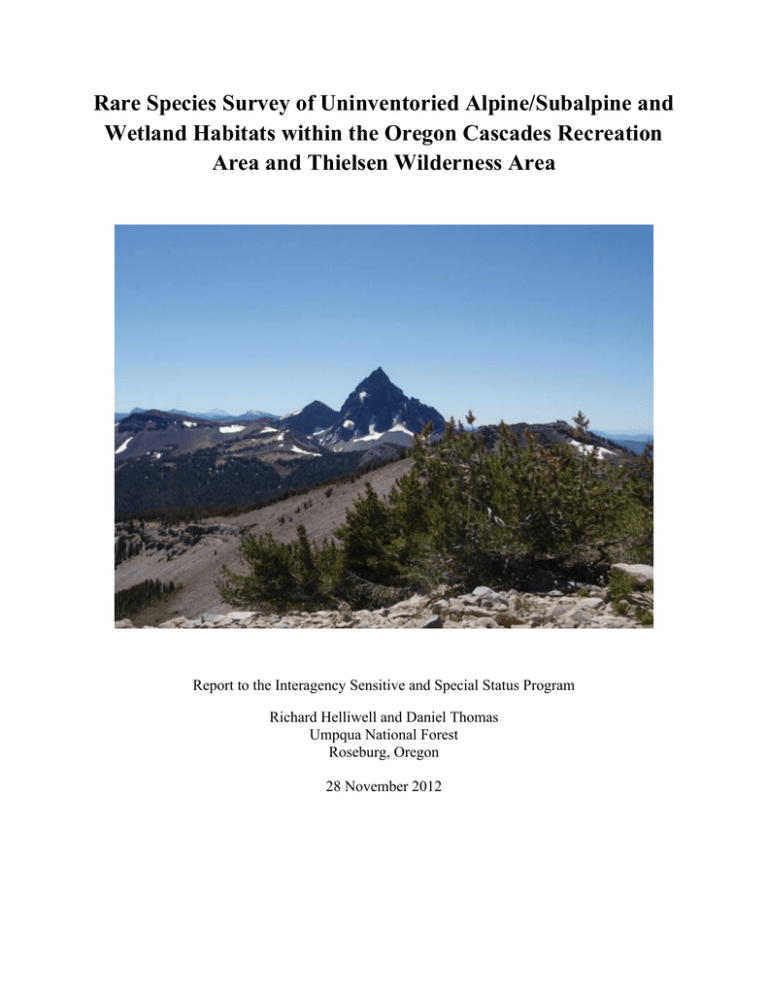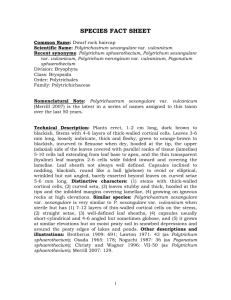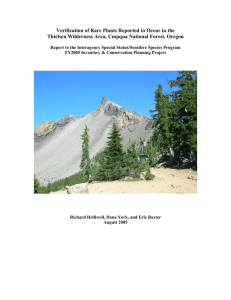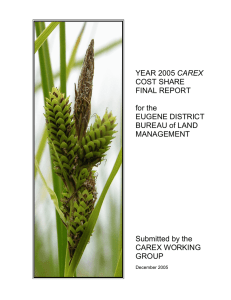Rare Species Survey of Uninventoried Alpine/Subalpine and
advertisement

Rare Species Survey of Uninventoried Alpine/Subalpine and Wetland Habitats within the Oregon Cascades Recreation Area and Thielsen Wilderness Area Report to the Interagency Sensitive and Special Status Program Richard Helliwell and Daniel Thomas Umpqua National Forest Roseburg, Oregon 28 November 2012 Introduction The Mt. Thielsen Wilderness Area and Oregon Cascades Recreation Area (OCRA) occupy the High Cascades crest north of Crater Lake National Park. This area has received little botanical exploration. In fact, other than the Pacific Crest Trail and the popular trail to the peak of Mt. Thielsen, the area gets relatively little use at all. At 2799 m (9182 ft.), Mt. Thielsen is the highest peak in the vicinity. This area was surveyed in 2005 as part of a separate Interagency Sensitive and Special Status Program funded survey (Helliwell, York and Baxter 2005). This previous inventory established that the reports of Arabis suffrutescens var. horizontalis and Carex atrosquama were misidentifications however a disjunct occurrence of rare C. nardina was discovered below the summit. Tipsoo Peak (2450 m, 8034 ft.) is the only other peak in the Wilderness that has a trail to it. This peak was informally surveyed on 9 July 2000. Tanya Harvey also produced a species list for Tipsoo Peak on 13 Aug. 2006. Otherwise, there are vascular plant collections at the Oregon State University Herbarium (OSC) from the Howlock Mountain area by Wayne Rolle from 1991 and V.L. Crosby from 1975. Based on the current Umpqua National Forest sensitive species list and habitats, the following target species were identified for survey: Anastrophyllum minutum, Anomobryum julaceum, Arabis suffrutescens var. horizontalis, Arnica viscosa, Asplenium septentrionale, Botrychium pumicola, Bryum calobryoides, Calamagrostis breweri, Carex crawfordii, Carex diandra, Carex lasiocarpa var. americana, Carex nardina, Carex vernacula, Chiloscyphus gemmiparus, Gentiana newberryi var. newberryi, Grimmia anomala, Gymnomitrion concinnatum, Harpanthus flotovianu,s Hygrohypnum alpinum, Jamesoniella autumnalis var. heterostipa, Meesia uliginosa, Pohlia tundra, Polytrichum sexangulare, Polytrichastrum sexangulare var. vulcanicum, Scapania obscura, Schistostega pennata, Schofieldia monticola, Trematodon asanoi and Tritomaria exsectiformis. Methods On 7-9 August 2012, Juliana Willsen, Andy Gustafson, Katina Verardo, and Daniel Thomas hiked into the Mt. Thielsen Wilderness area from the Tipsoo Mountain trailhead. The crew camped at the intersection of the Howlock Mountain trailhead and the Pacific Crest Trail, and the following morning climbed to the ridge of the crest of the cascades. Working in two groups, the crew surveyed south to Thielsen Creek (Verardo and Thomas) and northward to along Howlock Mountain (Gustafson and Willsen). On the north end of Howlock Mountain, a large volcanic extrusion precluded further safe travel along the ridge. Katy Weidman, Gabe Dour, and Dan Thomas returned on 23 August to survey from the base of Tipsoo to the north side of the volcanic extrusion, completing the target survey area. Judy Harpel and Richard Helliwell surveyed the wetlands associated with Warrior Creek on 19 September 2012 from the Kelsay Trailhead. Lightning caused wildfires had limited access to much of the target area prior to August. The botany crew members had been given a brief introduction the target species and directed to collect, where there was sufficient material, any vascular plant species that could be one of the target species. Photographs were taken of unknown species with populations too small to collect from. All bryophytes were collected as long as there was enough material. Vascular Plant identifications were made by Thomas and Helliwell. Bryophyte determinations were made by Harpel and Helliwell. Figures 1 & 2. Whitebark pine along Sawtooth Ridge and red needles on a whitebark pine caused by a mountain pine beetle infestation. Results and Discussion No detections were made of any of the target vascular plants. Occurrences of two species that the Oregon Natural Heritage Information Center (2010) is tracking were identified although both Hazardia whitneyi var. discoidea (G4G5, T4, S3) and Hieracium greenei (G3G4, SNR) were previously known from this area. There was one isolated Carex plant with a solitary spike similar to C. nardina that could only be photographed. The photographs are insufficient in detail to confidently assign a name to but it is probably just the common C. breweri. Festuca saximontana ssp. purpusiana is the most interesting collection that was made. It is known from Mt. Hood, Steens Mountain and the Wallowa Mountains. There are a few other unvouchered observations noted on the Oregon Flora Project’s atlas (http://www.oregonflora.org/atlas.) from the Cascades but none from or near the Mt. Thielsen Wilderness Area. Pinus albicaulis occurs scattered along the spine of Sawtooth Ridge (Figure 1) and Howlock mountain. Red needles known as branch flags (Figure 2) symptomatic of white pine blister rust (Cronartium ribicola) and mountain pine beetle (Dendroctonus ponderosae) were seen throughout the area as well. An outbreak of mountain pine beetle has been ongoing within the P. contorta forests around Diamond Lake and in Crater Lake NP for several years so it was not surprising to discovered pitch tubes of the mountain pine beetle on P. albicaulis. See Table 1 for the complete species list of plants that were either collected or observed. Figure 3. The largest of the meadows at Warrior Fen. The bryophyte inventory did yield new locations of rare species. Warrior Fen (Figure 3) is a collection of several wetlands at the headwaters of Warrior Creek in the OCRA, not all of which were able to be visited due to time limitations. There is a relatively large population of Helodium blandowii in the largest wetland. It occupies low, broad mounds under Vaccinium uliginosum along with Carex aquatilis and Tofieldia glutinosa. Mosses within the wetland are segregated in distinct bands apparently associated with moisture and perhaps pH or nutrients. Helodium blandowii occurs with Aulocomnium palustre on slightly elevated areas. Below these species is a band of Meesia triqetrus while Hamatocaulis vernicosus forms a lawn below the M. triqestrus. Floating in the open water below the lawn of H. vernicosus is Warnstorfia exannulata. The Helodium blandowii population is scattered within an approximately 0.3 acre area in west arm of the main meadow. New to the Umpqua National Forest is Lophozia laxa (Figure 4). This rare liverwort was discovered within a collection of Sphagnum capillifolium where it was intertwined with Cephalozia pleniceps as threads within the loose mat of sphagnum. The half red stem and the numerous tiny oil bodies are distinctive. This species was located only a few meters to the north of the H. blandowii population where S. capillifolium extends from the banks of open water along a low broad rise with scattered Carex sp. stems and Kalmia microphylla. This liverwort had been previously documented only on the Willamette National Forest in Oregon. Neither Mylia anomola nor Oncophorus virens have identified conservation concerns but are both new records for the Umpqua National Forest. Mylia anomala occurred in Lophozia vernicosa pockets within Sphagnum fuscum banks. Oncophorus virens is a widespread species in the Dicranaceae family. There were relatively few bryophytes found from Sawtooth Ridge or Howlock Mountain. These areas lacked the moisture to sustain bryophyte populations beyond tiny pockets of habitat within north-facing rock crevices. Much of what was collected consisted of sterile Pohlia sp. In the absence of sporophytes or brood bodies, no name can confidently be applied to these collections. Otherwise, Polytrichum juniperinum and Meiotrichum lyallii occurred sporadically above timberline in the rocks. These are typical species of the High Cascades. Pseudoleskea radicosa was a slight surprise to be found at such a high elevation but it is not an uncommon species locally. The most interesting specimen is what appears to be an atypical form of Polytrichum juniperinum. The toothed, bicolored hair point and the dense, dirty white rhizoids suggest the boreal P. hyperboreum, a species not known from south of Canada. However, the lack of branching and the slightly thickened apex of the marginal cells of the lamellae seem to place it more appropriately with the ubiquitous P. juniperinum. The upper reaches of Thielsen Creek near the Pacific Crest Trail yielded species typical of seepy, headwater streams including Philonotis fontana, Bryum pseudotriquetrum and B. weigellii. See Table 2 for the complete list of species encountered. Figure 4. Lophozia laxa after being dissected from the Sphagnum collection in which it was growing. Recommendations There has been enough survey completed on the Umpqua NF to recommend dropping Arabis suffrutescens var. horizontalis and Gentiana newberryi var. newberryi, as suspected species from the USFS sensitive list. The most likely habitat for both species has been inventoried and they are relatively conspicuous species that should have been detected if they were present. Lophozia laxa should be added to the sensitive list as documented on the Umpqua NF. The remaining species have uninventoried habitat on the forest. Literature Cited Helliwell, R., D. York and E. Baxter. 2005. Verification of Rare Plants Reported to Occur in the Thielsen Wilderness Area, Umpqua National Forest, Oregon, Report to the Interagency Special Status/Sensitive Species Program, Roseburg, Oregon. 15 pp. Oregon Biodiversity Information Center. 2010. Rare, Threatened and Endangered Species of Oregon. Institute for Natural Resources, Portland State University, Portland, Oregon. 105 pp. Figure 5. Vicinity Map of the inventoried areas. The starred locations indicate collection areas. Table 1. List of Vascular Plant collected or observed in the Sawtooth Ridge and Howlock Mountain areas. Aconogonon davisiae (A. Gray) Soják var. davisiae Anemone drummondii S. Watson var. drummondii Anemone occidentalis S. Watson Antenneria media Greene Arctostaphylos nevadensis A. Gray Arnica cordifolia Hook. Arnica mollis Hook. Boechera lemmonii (S. Watson) W.A. Weber Boechera lyallii (S. Watson) Dorn Calyptridium umbellatum (Torrey) Greene Cardamine bellidifolia L. Carex breweri Boott Carex halliana L.H. Bailey Carex nigricans C.A. Mey. Carex rossii Boott Carex straminiformis L.H. Bailey Carex subfusca cf. W. Boott Castilleja arachnoidea Greenm. Chimaphila umbellate (L.) W.P.C. Barton Claytonia megarhiza (A. Gray) S. Watson Cryptogramma acrostichoides R. Br. Elymus elymoides (Raf.) Swezey Epilobium glaberrinum Barbey ssp. fastigiatum (Nutt.) Hoch. & P.H. Raven Eremogone pumicola (Coville & Leiberg) Ikonn. Erigeron compositus Pursh var. compositus Erigeron nivalis Nutt. Eriogonum marifolium Torr. & A. Gray Eriogonum pyrolifolium Hook. var. coryphaeum Torr. & A. Gray Festuca saximontana Rydb. ssp. purpusiana (St.-Yves) Fred. & Pravick Hazardia whitneyi (A. Gray) Greene var. discoidea (J.T. Howell) W.D. Clark Hieracium greenei A. Gray Hieracium gracile Hook. (= H. triste Spreng.) Holodiscus microphyllus Rydb. var. glabrescens (Greenm.) F.A. Ley Hulsea nana A. Gray Ipomopsis congesta (Hook.) V.E. Grant var. montana (A. Nelson & P.B. Kenn.) Juncus drummondii E. Mey. Juncus parryi Engelm. Lewisia pygmaeus (Brand) J.M. Porter & L.A. Johnson Ligusticum grayi Coult. & Rose Lomatium martindalei (Coult. & Rose) Coult. & Rose Luetkea pectinata (Pursh) Kuntze Lupinus lepidus Lindl. var. lobbii (S. Watson) C.L. Hitchc. Luzula divaricata S. Watson Luzula hitchcockii Hämet-Ahti Micranthes tolmei (Torr. & A. Gray) Brouillet & Gornall Nothocalais alpestris (A. Gray) K. Chambers Orthilia secunda (L.) House Oxyria digyna (L.) Hill. Penstemon rupicola (Piper) Howell Phacelia hastata Lehm. ssp. compacta (Brand) Heckard Pinus albicaulis Engelm. Poa cusickii Vasey ssp. purpurascems (Vasey) Soreng Polemonium pulcherrimum Hook. Polygonum shastense W.H. Brewer Drymocallis glandulosa (Lindl.) Rydb. [= Potentilla g.(Lindl.)] Raillardella argentea (A. Gray) A. Gray Sagina saginoides (L.) H. Karst. Silene suksdorfii B.L. Rob. Trisetum spicatum (L.) K. Richt. Tsuga mertensiana (Bong.) Carrière Woodsia oregana D.C. Eaton ssp. oregana Vaccinium scoparium Coville Table 2. List of Bryophytes collected or observed in the Warrior Fen, Sawtooth Ridge and Howlock Mountain areas. Liverworts and Hornworts Anthoceros fusiformis Aust. Blepharostoma trichophyllum (L.) Dum. Calapogeia fissa (L.) Raddi Cephalozia pleniceps (Aust.) Lindb. Chiloscyphus polyanthus (L.) Corda Jungermannia leiantha Grolle Lophozia incisa (Schrad.) Dum. Lophozia laxa (Lindb.) Grolle Lophozia ventricosa (Dicks.) Dum. Marchantia polymorpha L. Mylia anomola (Hook.) S.Gray Pellia endiviifolia (Dicks.) Dum. Scapania cf. oaksii Aust. Scapania undulata (L.) Dum. Mosses Aulacomnium palustre (Hedw.) Schwaegr. Bartramia ithyphylla Brid. Brachythecium frigidium C. Mull.) Besch. Bryum pseudotriquetrum (Hedw.) Gaertn. et al. Bryum weigelii Spreng. in Biehler Ceratodon purpureus (Hedw.) Brid. Dicranoweissia crispula (Hedw.) Lindb. ex. Milde Drepanocladus aduncus (Hedw.) Warnst. Fontinalis antipyretica Hedw. Fontinalis neomexicana Sull. & Lesq. Hamatocaulis vernicosus (Mitt.) Hedenäs Helodium blandowii (Web. & Mohr.) Warnst. Heterocladium procurrens (Mitt.) Jaeg. Meesia triquetrus (Richt.) Ångstr. Meiotrichum lyallii (Mitt.) G.L. Smith Oncophorus virens (Hedw.) Brid. Philonotis fontana (Hedw.) Brid. Pohlia sp. Polytrichum commune Hedw. Polytrichum juniperinum Hedw. Pseudoleskea radicosa (Mitt.) Mac. & Kindb. Rhizomnium magnifolium (Horik.) T. Kop. Sanionia uncinata (Hedw.) Loeske Sphagnum capillifolium (Ehrh.) Hedw. Sphagnum fuscum (Schimp.) Klinggr. Sphagnum squarrosum Crome Warnstorfia exannulata (Schimp. in. B.S.G.) Loeske


![[[1]] Copy*1 H.M.S. Erebus Berkeley Sound Falkl[a]nd Nov[ember](http://s3.studylib.net/store/data/007561645_2-e073f5cfe18af2a59c8b5c1b789daea4-300x300.png)






